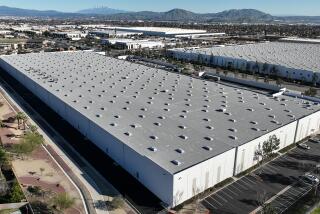Going on the Offense Over Ozone : Irvine’s Plan to Aid Planet Gets Mixed Response
To the mixed reaction of business people who will be affected by it, Irvine officials Tuesday formally announced their intention to help protect the planet’s ozone layer by restricting the use of solvents and other compounds.
Although other cities, including Los Angeles, have banned the use of plastic foam containers that have chlorofluorocarbons, or CFCs, Irvine’s proposed law goes after virtually all “ozone-depleting compounds.”
“We think it is the most far-reaching ordinance in the United States, and we think it will set the standard nationally and globally,” Irvine Mayor Larry Agran said at a news conference Tuesday.
Recycling Refrigerant
It would require, for example, that anyone repairing an air conditioner--on either a car or building--capture and recycle the refrigerant, one of the largest sources of CFCs. Current practice among mechanics is to allow the Freon gas to escape into the air.
Under the ordinance, mechanics would have to purchase approved recycling units--estimated by city officials to cost between $3,000 and $5,000--that would suck the Freon out of the air conditioners and cleanse it for reuse. Even do-it-yourself mechanics would not be allowed to purchase the refrigerant unless they could prove to the store that they have a licensed recycling system, according to the ordinance.
The ordinance would also restrict the use of solvents in manufacturing, degreasing and sterilizing and prohibit the use in construction of insulation utilizing CFCs. Further, it would ban the use of CFC foam containers at restaurants and grocery stores, and require that Halon, a tetrafluoroethylene polymer used in fire-extinguishing systems, be reclaimed during testing.
And the ordinance would establish the position of “environmental program coordinator” to oversee the ordinance and work with businesses to help them comply. City officials estimate that 10% of Irvine’s 5,500 businesses would be affected.
CFCs damage the Earth’s protective ozone layer. For every 1% depletion in the ozone layer, there is a 2% increase in solar radiation hitting the Earth, increasing the risk of cancer, cataracts and immune deficiencies, Agran said.
“These are not the types of things we can play games with,” he said. “This is an issue of global survival.”
The City Council will hold a public hearing on the ordinance June 29. Until then, city officials will be mailing letters to businesses and asking them to complete a brief questionnaire to gauge reaction.
But Irvine’s proposed law does not sit favorably with the Alliance for a Responsible CFC Policy, an organization based in Rosslyn, Va., and representing CFC manufacturers. Executive director Kevin Fay said Tuesday that he has not heard of Irvine’s proposed law but that the organization believes that local governments are more effective if they limit their own use of CFCs, rather than legislate against them.
The industry is attempting to develop substitutes for CFCs, and local laws banning products interfere with the orderly transition, Fay said. He said the United States and about 45 other countries on 1987 signed a treaty pledging to reduce the use of CFCs 50% in 10 years and phase them out completely by the turn of the century.
“We’ve got our work cut out for us. We know what we have to do,” Fay said. If local governments pass their own versions of the treaty, he said, it creates havoc and tracking difficulties.
Firm Took Early Steps
At least one Irvine business was not surprised by the move.
Earlier this year--well in advance of the July 1, 1990, deadline proposed by city officials--Western Digital, a manufacturer of computer components, took steps to eliminate CFCs from its production plants.
“We feel this is good for the environment, and the (CFC restrictions) were something we had been anticipating,” said John R. MacKay, senior vice president of manufacturing. But he said the biggest reason for the change to a non-CFC process--at a cost of $200,000--is that it saves the company money.
The firm had used CFCs as a solvent to clean soldering residue from printed circuit boards that it produces for the personal computer industry.
“It’s slightly cheaper using a water-based process,” MacKay said. “And we think we’ll pay off the development costs within the next year.”
But news of the proposed ordinance received a mixed reaction Tuesday from other Irvine businesses.
Although several auto repairmen said they believe such controls are inevitable, some said that purchasing the costly Freon recycling machines will cut into the budgets of the small, independent service stations more deeply than the service departments of large car dealerships.
“I’m all for helping the environment and such, but it has to be done in a cost-effective way,” said Dan Russell, manager of a Chevron station in the city. “The city isn’t the one that pays the bills or pays for the repairs (to the recycling machine) or pays for the maintenance contract.”
If those costs result in higher prices, Russell said, “then the customers will drive out of Irvine to Costa Mesa to have it serviced.”
Mechanic Rick Cain at a Unocal station in Irvine questioned how much difference Irvine’s ordinance will make to the planet’s ozone layer.
“Irvine itself is not going to make any major contribution to the ozone level. You’re talking one tiny suburb here,” Cain said. “If it’s going to be done, it should be done on a worldwide level.”
Support for Proposed Law
But the service manager for Irvine Mitsubishi said he supports the proposed law.
“You’ve got to start nipping at it somewhere,” Jim Bates said. “I personally think it is something that will have to happen.” He does not anticipate higher prices for the customer because, he said, the equipment will eventually pay for itself if it recycles the refrigerant.
Rex J. White, owner of RJW Air Conditioning & Heating in Anaheim, said the cost of recycling CFCs will be passed on to customers in the form of higher service charges. Although some customers already complain about the industry’s service fees of $50 per hour or more, he favors the law if it will help the environment.
“If it’s something that needs to be done to protect my future and my family’s,” White said, “then I’m all for it.”
Spokeswomen for McDonald’s and Carl’s Jr., which have several restaurants in Irvine, said they stopped using containers with CFCs last year.
Phasing Out Foam Products
Further, grocery stores have been phasing out the use of CFC foam containers for meat and even the sale of CFC foam plates and cups for the past year or more, said Steven Koff, president of the Southern California Grocers Assn. “There are a variety of foam products that do not contain CFCs, and that’s the direction we’re heading in.”
Representatives of builders in Irvine could not be reached for comment regarding the proposed law.
Mayor Agran and City Councilman Cameron Cosgrove said Irvine businesses are not being unfairly burdened. Instead, Agran insisted, they will have a “competitive edge” over other businesses elsewhere when state and federal restrictions on CFCs inevitably are imposed.
But even mechanics supportive of the ordinance doubted that assessment, saying that as more technology is developed to deal with CFCs, the cost of the equipment is bound to drop.
Not a Token Attempt
Agran said Irvine’s law is not a token attempt to help the ozone. “We think it is very important that cities undertake the responsibility to see that the global environment is adequately protected.”
Many environmental protections have begun on a local level before spreading to the state and nation, Agran said. Further, he said, it is fitting for Irvine to propose a stringent ordinance governing CFCs because much of the pioneering research was performed at UC Irvine by Prof. F. Sherwood Rowland.
Standing in Irvine’s 2-month-old City Hall, the mayor admitted that the new building does not completely meet the requirements of the proposed ordinance, which was not yet in the works when construction and purchasing were under way.
There are some firm foam chairs in City Hall that probably violate the proposed ordinance, Agran said, but he added that all servicing of the air conditioning and future purchases will be studied closely.
The city did make one purchase with its eye on the environment, he added. Rather than stock cabinets with foam coffee cups, the city “bought every employee a ceramic mug.”
PROTECTING THE OZONE
The proposed Irvine restrictions on ozone-damaging chemicals--chlorofluorocarbons (CFC) and tetrafluoroethylene polymer (Halon)--would take effect July 1, 1990. The provisions would:
Bar the manufacture of any ozone-depleting substance.
Bar sale, purchase or use of food-packaging materials made of any ozone-depleting substance.
Bar installation of building insulation containing any ozone-depleting substance.
Restrict removal of ozone-depleting substances from construction to proper recovery and disposal (specifics yet to be determined).
Require refrigeration and air-conditioning repair facilities to recycle and prevent release into the atmosphere of ozone-depleting chemicals.
Bar sale of ozone-depleting coolants for refrigeration or air-conditioning units, unless buyer has certified recycling system.
Bar disposal of any ozone-depleting chemical from refrigeration or air-conditioning unit without recycling.
Restrict use of Halon in fire extinguisher testing or training to instances required by law or to those with proper city permit.
Require fire extinguisher service and repair facilities to recycle any Halon.
Exceptions include licensed health-care facilities using these chemicals for sterilization, research on the effects of these chemicals and research on alternative technologies.
Fines would be up to $50 for first violation, up to $100 for second violation and up to $250 for each additional violation. Each day of non-compliance would be a violation.
Source: City of Irvine OZONE CURBS ELSEWHERE
Several government bodies have barred products made with ozone-depleting chemicals. Many of the bans also include plastics that are not biodegradable or recyclable.
Vermont: Legislature barred automobile air conditioners that use chlorofluorocarbons (CFC), effective 1993 model year.
Hawaii: Legislature barred the sale of cartridges for recharging car air conditioners with CFC coolants and raises standards for repair of car air conditioners.
Florida: Legislature barred polystyrene foam containers for restaurants and food vendors. Berkeley: City Council barred fast-food outlets from using foam plastic packaging made with CFC.
Portland, Ore.: City Council barred foam food containers made with CFC.
Minneapolis: City Council barred plastics for food packaging and grocery stores that are not biodegradable, returnable or collectible for recycling, effective July, 1990.
Suffolk, N.Y.: City Council barred foam food containers made with CFC, effective July, 1989.
Los Angeles: City Council barred the sale, manufacture and distribution of plastic foam products made with CFC, effective July 1, 1989.
UC San Diego: Barred the use of Styrofoam on campus.
Nationwide: The Environmental Protection Agency proposed a 50% cut of 1986 CFC production levels.
Salem, Ore.: City Council rejected ban of foam food containers made with CFC.
More to Read
Sign up for Essential California
The most important California stories and recommendations in your inbox every morning.
You may occasionally receive promotional content from the Los Angeles Times.










